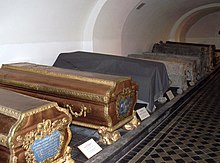Jelgava Castle
Jelgava Castle (also: Mitau Castle , Latvian Jelgavas pils ) is the largest baroque castle in the Baltic States . It was built in the 18th century according to plans by Bartolomeo Francesco Rastrelli as the seat of the rulers of the Dukes of Courland and Zemgale in their capital Mitau (today: Jelgava ). The nearby Rundāle Palace , also planned by Rastrelli, served the dukes as their summer residence .
history
On the island between the Courland Aa ( Lielupe ) and its side arms, Mitau Castle was built by the Knights of the Sword Brothers in 1265 . The initially wooden building burned down and was replaced by a new stone building in 1345, which served as the residence of the dukes of the Kettler dynasty .
Ernst Johann von Biron , the favorite of the widow of the last Duke of Kettler and later Tsarina Anna , had the old castle demolished in 1738 and commissioned the construction of a palace. After Biron fell out of favor in 1740, all construction work was interrupted, although the roof was not yet in place at the time. The work was not resumed until 1763 after Biron had returned from exile. In addition to Rastrelli, who was active in Courland after the death of his sponsor Tsarina Elisabeth , the Dane Severin Jensen was involved as a planner who added classical elements to the palace. The castle was finished in 1772, and Ernst Johann von Biron died six months later.
In 1779, his successor Peter von Biron accommodated the adventurer Alessandro Cagliostro in the castle. After Courland was annexed by the Russian Empire in 1795 and the Biron von Curland ducal house was financially compensated, the castle became a refuge for French nobles who had to leave their homeland because of the French Revolution . Louis XVIII and his family lived in the castle between 1797 and 1801. Marie Thérèse Charlotte of France married Louis-Antoine of Bourbon, the prince of Angoulême, who pretended to be the throne .
In 1919 the interior of the palace was destroyed when troops of the West Russian Liberation Army under Pawel Bermondt-Awaloff plundered and pillaged while retreating. The castle also suffered severe damage in the Second World War during the fighting in the summer of 1944. The castle was restored between 1956 and 1964, whereby the building shell was limited. Since 1939 the castle has housed the Latvian Agricultural University .
architecture
Jelgava Castle consists of a four-wing complex that surrounds an inner courtyard. Originally, the castle of two wings to the main building in the form of a consisted U were connected. In 1937 another wing was added to the complex, which closed the courtyard. The baroque facades of the palace, which is surrounded by greenery, are structured by means of a central and side risalite .
The crypt of the Dukes of Courland and Zemgale in the south-western basement is of historical importance . All the dukes from the houses of Kettler and Biron were buried here between 1569 and 1791. The premises contain 21 stone sarcophagi and nine wooden coffins. The crypt was moved to the castle in 1819.
360 degree images
Individual evidence
- ↑ Jelgava Castle
- ^ Edward T. Corp, Edward Gregg, Howard Erskine-Hill: A Court in Exile . Cambridge University Press, 2004. ISBN 0521584620 , p. 5.
Web links
Coordinates: 56 ° 39 '20.9 " N , 23 ° 43' 58.8" E


